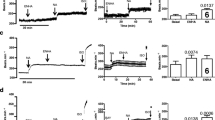Summary
Background: Regional accumulation of myocardial cyclic AMP may play a role in the genesis of ventricular arrhythmias. Myocardial levels of cAMP are regulated by the activities of adenylyl cyclase and at least four cyclic nucleotide phosphodiesterase (PDE) isoenzymes, suggesting that both activation of adenylyl cyclase or inhibition of PDEs could be arrhythmogenic. Goal: The present experiments were designed to examine the effects of selective and non-selective inhibitors of PDE isoenzymes on heart rhythm in pigs. Methods: The inhibitors were tested by local intramyocardial infusion (20 µ1/min) with or without coinfusion of known activators of adenylyl cyclase (noradrenaline). Epicardial electrocardiogram and aortic blood pressure were recorded. Results: Intramyocardial infusion of noradrenaline (10−6 M) precipitated ventricular tachycardia within 60–90 s after start of the infusion (up to 95% efficacy). Likewise, infusion of milrinone or piroximone (i.e., selective inhibitors of the low Km cGMP-inhibited PDE III) (≥ 10−4 M) produced local pacemaking activity within 3 min The tachycardia could be maintained for more than 10 min by continuous infusion and was readily reversed by stopping the infusion. The order of potency of compounds was milrinone = piroximone»enoximone (measured at 5 · 10−4 M). The maximal frequency of VT induction was 57% (milrinone), 50% (piroximone), and 13% (enoximone). The PDE IV inhibitor rolipram had relatively weak arrhythmogenic effects (7%). The effects of nonselective PDE inhibitors were variable. While VT was induced infrequently by papaverine (up to 17%), it could not be induced by infusing theophylline (up to 10−2 M tested). Coinfusion of noradrenaline and PDE III inhibitors did not facilitate the induction of local pacemaking activity by the catecholamine (only enoximone and piroximone tested). Conclusion: The present data suggest that isozyme selective PDE inhibitors have variable arrhythmogenic effects; the strongest effects are seen with selective PDE III inhibitors (milrinone, piroximone), when infused at a concentration that causes half-maximal inhibition of the PDE III isoenzyme in vitro. The observed arrhythmogenic effects of PDE III inhibitors appear to be mediated by cAMP.
Access this chapter
Tax calculation will be finalised at checkout
Purchases are for personal use only
Preview
Unable to display preview. Download preview PDF.
Similar content being viewed by others
References
Beavo JA, Reifsnyder DH (1990) Primary sequence of cyclic nucleotide phosphodiesterase isozymes and the design of selective inhibitors. Trends in Pharmacol Sci 11: 150–155
Kameyama M, Hofmann F, Trautwein W (1985) On the mechanism of ß-adrenergic regulation of the Ca channel in the guinea-pig heart. Plügers Arch 405: 285–293
Packer M, Carver JR, Rodeheffer RJ, Ivanhoe RJ, DiBianco R, Zeldis SM, Hendrix GH, Bommer WJ, Elkayam U, Kukin ML, Malls GI, Sollano JA, Shannon J, Tandon PK, DeMets DL (1991) Effect of oral milrinone on mortality in severe chronic heart failure: Promise study research group. N Engl J Med 325: 1468–1475
Podzuweit T (1980) Catecholamine-cyclic-AMP-Ca2+-induced ventricular tachycardia in the intact pig heart. Basic Res Cardiol 75: 772–779
Podzuweit T, Lubbe WF, Opie LH (1976) Cyclic adenosine monophosphate, ventricular fibrillation, and antiarrhythmic drugs. Lancet I: 341–342
Podzuweit T, Nennstiel P, Müller A, Schaper W (1991) Absence of cytosolic calciumcalmodulin-stimulated cyclic nucleotide phosphodiesterase in pig myocardium. FASEB J 5: 70–87
Reeves ML, Leigh BK, England PJ (1987) The identification of a new cyclic nucleotide phosphodiesterase activity in human and guinea-pig cardiac ventricle. Biochem J 241: 535–541
Szekeres L, Boros E, Pataricza J, Udvary É (1986) Sympathetic neural mechanisms in cardiac arrhythmias. J Mol Cell Cardiol 18: 369–373
Weishaar RE, Kobylarz-Singer DC, Kaplan HR (1987) Subclasses of cyclic AMP phosphodiesterase in cardiac muscle. J Mol Cell Cardiol 19: 1025–1036
Yatani A, Codina J, Imoto Y, Reeves JP, Birnbaumer L, Brown AM (1987) A G protein directly regulates mammalian cardiac calcium channels. Science 238: 1288–1293
Author information
Authors and Affiliations
Editor information
Editors and Affiliations
Rights and permissions
Copyright information
© 1994 Dr. Dietrich Steinkopff Verlag GmbH & Co. KG, Darmstadt
About this chapter
Cite this chapter
Podzuweit, T., Bader, R., Nennstiel, P., Müller, A. (1994). Arrhythmogenic effects of selective inhibition of cyclic nucleotide phosphodiesterase isoenzymes in pig myocardium. In: Zehender, M., Meinertz, T., Just, H. (eds) Myocardial Ischemia and Arrhythmia. Steinkopff. https://doi.org/10.1007/978-3-642-72505-0_3
Download citation
DOI: https://doi.org/10.1007/978-3-642-72505-0_3
Publisher Name: Steinkopff
Print ISBN: 978-3-642-72507-4
Online ISBN: 978-3-642-72505-0
eBook Packages: Springer Book Archive




